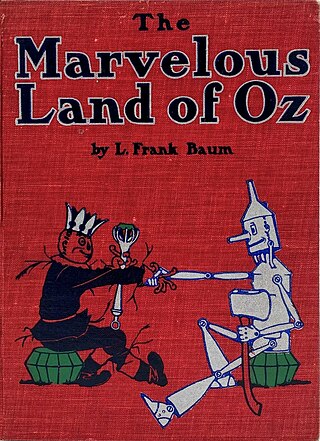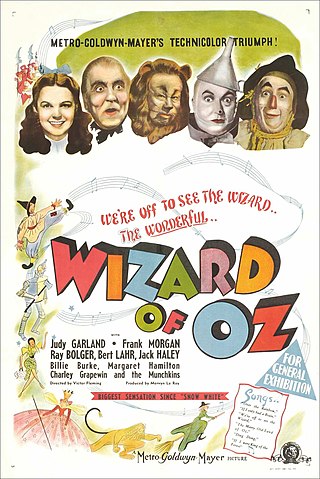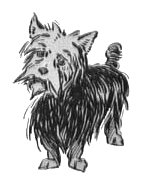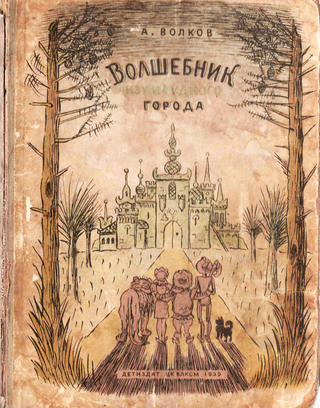
Lyman Frank Baum was an American author best known for his children's fantasy books, particularly The Wonderful Wizard of Oz, part of a series. In addition to the 14 Oz books, Baum penned 41 other novels, 83 short stories, over 200 poems, and at least 42 scripts. He made numerous attempts to bring his works to the stage and screen; the 1939 adaptation of the first Oz book became a landmark of 20th-century cinema.
The Wonderful Wizard of Oz or The Wizard of Oz most commonly refers to:

The Wonderful Wizard of Oz is a 1900 children's novel written by author L. Frank Baum and illustrated by W. W. Denslow. It is the first novel in the Oz series of books. A Kansas farm girl named Dorothy ends up in the magical Land of Oz after she and her pet dog Toto are swept away from their home by a cyclone. Upon her arrival in the magical world of Oz, she learns she cannot return home until she has destroyed the Wicked Witch of the West.

The yellow brick road is a central element in the 1900 children's novel The Wonderful Wizard of Oz by American author L. Frank Baum. The road also appears in the several sequel Oz books such as The Marvelous Land of Oz (1904) and The Patchwork Girl of Oz (1913).

The Marvelous Land of Oz: Being an Account of the Further Adventures of the Scarecrow and the Tin Woodman, commonly shortened to The Land of Oz, published in July 1904, is the second of L. Frank Baum's books set in the Land of Oz, and the sequel to The Wonderful Wizard of Oz (1900). This and the next 34 Oz books of the famous 40 were illustrated by John R. Neill. The book was made into an episode of The Shirley Temple Show in 1960, and into a Canada/Japan co-produced animated series of the same name in 1986. It was also adapted in comic book form by Marvel Comics; once in 1975 in the Marvel Treasury of Oz series, and again in an eight issue series with the first issue being released in November 2009. Plot elements from The Marvelous Land of Oz are included in the 1985 Disney feature film Return to Oz.

Dorothy Gale is a fictional character created by American author L. Frank Baum as the protagonist in many of his Oz novels. She first appears in Baum's classic 1900 children's novel The Wonderful Wizard of Oz and reappears in most of its sequels. In addition, she is the main character in various adaptations, notably the classic 1939 film adaptation of the novel, The Wizard of Oz.

Oscar Zoroaster Phadrig Isaac Norman Henkle Emmannuel Ambroise Diggs is a fictional character in the Land of Oz created by American author L. Frank Baum. The character was further popularized by a stage play and several films, including the classic 1939 film and the 2013 prequel adaptation.

Nick Chopper, the Tin Woodman, also known as the Tin Man or Tin Woodsman, is a character in the fictional Land of Oz created by American author L. Frank Baum. He first appeared in his 1900 book The Wonderful Wizard of Oz and reappeared in many other subsequent Oz books in the series. In late 19th-century America, men made out of various tin pieces were used in advertising and political cartoons. Baum, who was editing a magazine on decorating shop windows when he wrote The Wonderful Wizard of Oz, was inspired to invent the Tin Woodman by a figure he had built out of metal parts for a shop display.

The Wizard of Oz is a 1939 American musical fantasy film produced by Metro-Goldwyn-Mayer (MGM). An adaptation of L. Frank Baum's 1900 children's fantasy novel The Wonderful Wizard of Oz, the film was primarily directed by Victor Fleming, who left production to take over the troubled Gone with the Wind. It stars Judy Garland, Frank Morgan, Ray Bolger, Bert Lahr, Jack Haley, Billie Burke, and Margaret Hamilton. Noel Langley, Florence Ryerson, and Edgar Allan Woolf received credit for the screenplay, while others made uncredited contributions. The music was composed by Harold Arlen and adapted by Herbert Stothart, with lyrics by Edgar "Yip" Harburg.

The Scarecrow is a character in the fictional Land of Oz created by American author L. Frank Baum and illustrator W.W. Denslow. In his first appearance, the Scarecrow reveals that he lacks a brain and desires above all else to have one. In reality, he is only two days old and merely naïve. Throughout the course of the novel, he proves to have the brains he seeks and is later recognized as "the wisest man in all of Oz," although he continues to credit the Wizard for them. He is, however, wise enough to know his own limitations and all too happy to hand the rulership of Oz, passed to him by the Wizard, to Princess Ozma, and become one of her trusted advisors, though he typically spends more time having fun than advising.

Toto is a fictional dog in L. Frank Baum's Oz series of children's books, and works derived from them. His name is pronounced with a long "O", a homophone of "toe toe". He was originally a small terrier drawn by W. W. Denslow for the first edition of The Wonderful Wizard of Oz (1900). He reappears in numerous adaptations, such as The Wizard of Oz (1939) and The Wiz (1978).

The Dreamer of Oz: The L. Frank Baum Story is a 1990 American made-for-television biographical film starring John Ritter as Lyman Frank Baum, the author who wrote the 1900 novel The Wonderful Wizard of Oz and thirteen other Oz books. Also starring in it were Annette O'Toole as Baum's supportive wife, Maud, and Rue McClanahan as Baum's tough mother-in-law, Matilda Gage.

The Wonderful Wizard of Oz is a 1910 American silent fantasy film and the earliest surviving film version of L. Frank Baum's 1900 novel The Wonderful Wizard of Oz, made by the Selig Polyscope Company without Baum's direct input. It was created to fulfill a contractual obligation associated with Baum's personal bankruptcy caused by The Fairylogue and Radio-Plays, from which it was once thought to have been derived. It was partly based on the 1902 stage musical The Wizard of Oz, though much of the film deals with the Wicked Witch of the West, who does not appear in the musical.
"The Merry Old Land of Oz" is a song from the 1939 film The Wizard of Oz and the musical. It is sung by the townspeople of the Emerald City, who are joined at appropriate times by the group of four travelers: Dorothy, Scarecrow, Tin Man and Cowardly Lion. It was written by lyricist E.Y. Harburg and composer Harold Arlen. The verse of the song suggests that the people of the city do no actual work, since they "get up at twelve, and start to work at one, take an hour for lunch, and then at two they're done". Their actions contradict that funny sentiment, however, as they are clearly doing plenty of work to "freshen up" the group of four to go see the Wizard. The revelers' laughter is interrupted by the Wicked Witch of the West, who is circling over the city, skywriting with her broom, ordering the citizens to "SURRENDER DOROTHY OR DIE". In the final cut of the film, the words "OR DIE" were dropped from the film as being too strong for the presumably young audience of the time.
Lion of Oz is a 2000 animated film set before the 1900 children's novel The Wonderful Wizard of Oz. It tells the story of how the Cowardly Lion, formerly part of the Omaha Circus, came to be in Oz and how he stopped the Wicked Witch of the East from getting the Flower of Oz. It is based upon the 1995 book Lion of Oz and the Badge of Courage by Roger S. Baum.
The Wonderful Land of Oz is a 1969 film directed by Barry Mahon. It is a low budget but faithful adaptation of the 1904 novel The Marvelous Land of Oz by L. Frank Baum.

The Wizard of the Emerald City is a 1939 children's novel by Russian writer Alexander Melentyevich Volkov. The book is a re-narration of L. Frank Baum's The Wonderful Wizard of Oz. Baum's name is sometimes credited in the book. The names of most characters are changed, some elements of Baum's novel are removed, and some new elements are added. In 1959 a new edition of the book was published, significantly revised by the author. This edition first featured illustrations by artist L.V. Vladimirsky and became popular in the 1960s, leading to five sequels: Urfin Jus and his Wooden Soldiers (1963), The Seven Underground Kings (1964), The Fiery God of the Marrans (1968), The Yellow Fog (1970), and The Secret of the Abandoned Castle. These sequels were written by Volkov himself and are not based on Baum's plot elements, although we do encounter the powder of life, a character called Charlie Black who is not unlike Cap'n Bill, intelligent foxes, and the use of a Sandboat similar to Johnny Dooit's, albeit with wheels.

The Wonderful Wizard of Oz is a 1900 children's novel written by American author L. Frank Baum. Since its first publication in 1900, it has been adapted many times by L. Frank Baum and others: for film, television, theatre, books, comics, games, and other media.
Twister: A Ritual Reality in Three Quarters Plus Overtime if Necessary, is a 1999 play by Ken Kesey, loosely based on L. Frank Baum's novel, The Wonderful Wizard of Oz and the 1939 film version, The Wizard of Oz. The play also features the West African deity Legba.

After the Wizard is an independent 2011 fantasy film written and directed by Hugh Gross, based on the 1900 novel The Wonderful Wizard of Oz by L. Frank Baum. The film premiered in 2011 in Kingman, Kansas. The DVD, distributed by Breaking Glass Pictures, was released on August 7, 2012.














